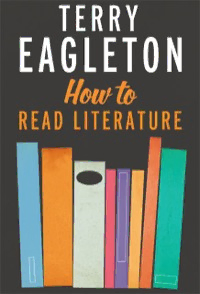
How to Read Literature PDF
Preview How to Read Literature
HOW TO READ LITERATURE 4023.indd 1 14/03/13 4:25 PM HOW TO READ LITERATURE TERRY EAGLETON YALE UNIVERSITY PRESS NEW HAVEN AND LONDON 4023.indd 3 14/03/13 4:25 PM Copyright © 2013 Yale University All rights reserved. This book may not be reproduced in whole or in part, in any form (beyond that copying permitted by Sections 107 and 108 of the U.S. Copyright Law and except by reviewers for the public press) without written permission from the publishers. For information about this and other Yale University Press publications, please contact: U.S. Office: [email protected] www.yalebooks.com Europe Office: sales @yaleup.co.uk www.yalebooks.co.uk Set in Arno Pro by IDSUK (DataConnection) Ltd Printed in Great Britain by TJ International Ltd, Padstow Cornwall Library of Congress Cataloging- in- Publication Data Eagleton, Terry, 1943- How to read literature / Terry Eagleton. pages cm ISBN 978-0-300-19096-0 (cl : alk. paper) 1. Literature—Philosophy. 2. Authors and readers. 3. Reader-response criticism. 4. Literature—Explication. I. Title. PN49.E25 2013 801—dc23 2013001802 A catalogue record for this book is available from the British Library. 10 9 8 7 6 5 4 3 2 1 For permission to reprint poetry extracts from copyright material the publishers gratefully acknowledge Farrar, Straus and Giroux for lines from Robert Lowell’s ‘The Quaker Graveyard in Nantucket’; and Faber and Faber Ltd, and Farrar, Straus and Giroux for lines from Philip Larkin’s ‘The Trees’ and ‘Whitsun Weddings’. In memory of Adrian and Angela Cunningham 4023.indd 5 14/03/13 4:25 PM 4023.indd 6 14/03/13 4:25 PM Contents Preface ix 1 Openings 1 2 Character 45 3 Narrative 80 4 Interpretation 117 5 Value 175 Index 207 4023.indd 7 14/03/13 4:25 PM 4023.indd 8 14/03/13 4:25 PM Preface Like clog dancing, the art of analysing works of literature is almost dead on its feet. A whole tradition of what Nietzsche called ‘slow reading’ is in danger of sinking without trace. By paying close attention to literary form and technique, this book tries to play a modest part in riding to its rescue. It is mainly intended as a guide for beginners, but I hope it will also prove useful to those already engaged in literary studies, or those who simply enjoy reading poems, plays and novels in their spare time. I try to shed some light on such questions as narrative, plot, character, literary language, the nature of fiction, problems of critical interpretation, the role of the reader and the question of value judgements. The book also puts forward some ideas about individual authors, as well as about such literary currents as classicism, romanticism, modernism and realism, for those who might feel in need of them. I am, I suppose, best known as a literary theorist and political critic, and some readers might wonder what has become of these interests in this book. The answer is that one cannot raise political or theoretical questions about literary texts without a degree of sensitivity to their language. My concern here is to provide readers 4023.indd 9 14/03/13 4:25 PM How to Read Literature and students with some of the basic tools of the critical trade, without which they are unlikely to be able to move on to other matters. I hope to show in the process that critical analysis can be fun, and in doing so help to demolish the myth that analysis is the enemy of enjoyment. TE x 4023.indd 10 14/03/13 4:25 PM
Description:What makes a work of literature good or bad? How freely can the reader interpret it? Could a nursery rhyme like Baa Baa Black Sheep be full of concealed loathing, resentment, and aggression? In this accessible, delightfully entertaining book, Terry Eagleton addresses these intriguing questions and a host of others. How to Read Literature is the book of choice for students new to the study of literature and for all other readers interested in deepening their understanding and enriching their reading experience.
In a series of brilliant analyses, Eagleton shows how to read with due attention to tone, rhythm, texture, syntax, allusion, ambiguity, and other formal aspects of literary works. He also examines broader questions of character, plot, narrative, the creative imagination, the meaning of fictionality, and the tension between what works of literature say and what they show. Unfailingly authoritative and cheerfully opinionated, the author provides useful commentaries on classicism, Romanticism, modernism, and postmodernism along with spellbinding insights into a huge range of authors, from Shakespeare and J. K. Rowling to Jane Austen and Samuel Beckett.
